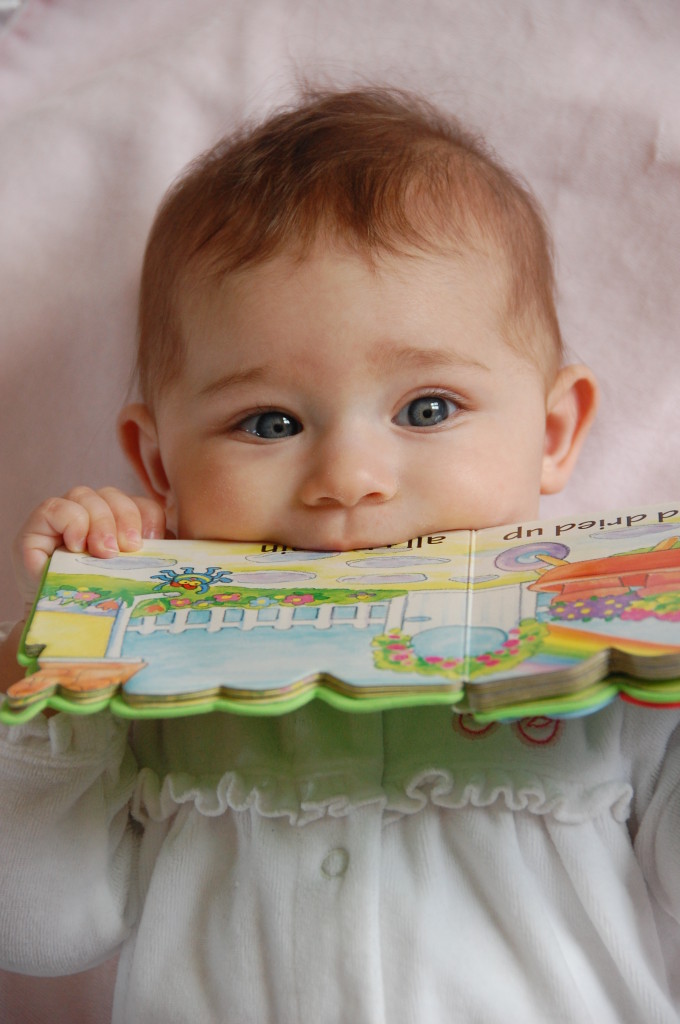
Read it or eat it!
Reading out loud is a crucial part of bilingual parenting.It’s the primary way to link spoken words, written words, ideas and images all together — and it’s valuable bonding time for parents, too.
Infants are such an amazing listeners!
They won’t say no to you, they won’t run away, they are not picky about what book you are reading. We as parents need to use this golden time to a full potential.
These five tips will help you start your baby on reading :
1. Give Reading High Priority
As a parent of a baby, you always make sure he is fed, not tired, changed and warm. The constant circle of these 4 simple activities take almost all your day when you take care about an infant. But reading time should be one of the most important things in a young child’s schedule as well, whether you’re raising the child bilingual or not!
You should always be looking for new books to keep you infant entertained. “Favorites” will develop quickly — and you can expect to read those over and over and over again — but there should always be something new for the baby as well.
Unfortunately, it’s not always easy to find an endless supply of baby books in two different languages. One trick we’ve used is simply reading an English-language book aloud in a different language ( Russian and Ukrainian in our case). Your baby isn’t trying to read the words on the page, so it doesn’t matter too much that the printed syllables and the spoken ones aren’t the same.
But the real key is in the parenting itself. Make the act of reading itself something that’s prioritized. We let our kids get away with a little more when we read to them: they can stay up a little later, or be in our bed when they’re not usually supposed to, which teaches them that reading is something important enough to take priority over other rules.
Building that habit early makes it easy to keep the kids reading once they get older and start to experiment with reading on their own — a topic for another article!
2. Use Age-Appropriate Books in Both Languages

Use Age-Appropriate Books in Both Languages
Try to keep the content of your reading similar from one language to the next.
You want all your children’s books to be on about the same level. So, as the words and sentences become more complex in English (or another community language), make sure you’re increasing the complexity of the heritage language as well.
For your sake, you should also try to keep the actual physical material of the book as age-appropriate as possible. It’s worth paying a little extra to get some baby books in a foreign language online if it means they’re made from sturdy cardboard that can hold up to some drool and chewing!
Printed-out materials on stock paper or little pamphlets from some of the bilingual education programs that are out there are a nice idea, but they don’t actually withstand the terrors of an infant very well.
3. Be Loud and Emotional
Remember, the words you’re using aren’t really getting through yet. They’re becoming part of a pattern that your child will recognize, in time, but you haven’t hit that point.
What you say is less important than how you say it. Make the words big, exciting, and fun.
Animal noises are always favorites here (and can actually be part of a bilingual education, too — what a cat “says” in English is very different from what it “says” in Russian or Japanese or French). But anything big and noisy is going to have more impact than something sedate.
There’s a time and a place for reading quietly, of course. The last book before bed should be a quiet one, for your sake as much as your children’s. But before then, use lots of noise and emotion to keep your infant’s attention on your voice — that’s what’s teaching them their languages, even if they don’t know it yet.
4. Smile When You Read
This is, to be fair, good advice for all parents doing read-aloud, not just parents raising their children bilingual.
But it is important. The shape of your face affects your voice. When you smile, you sound more pleasant. It’s also more comforting for the child if he or she looks up (and children will — they don’t stay focused intently on the book 100% of the time).
Keep your voice and your expression pleasant so that your children have a fondness for the sound of the languages you’re using imprinted at an early age. This is especially important if you’re using a system where the parents speak different languages — you don’t want the kids to end up more leery of one language because Daddy frowns when he reads!
5. Name Everything in the Book
Don’t limit yourself to the text of the book.
Point at all the objects and name them. Make sure this is happening in all the languages you’re teaching, not just one — that doesn’t just teach the children new words, it also teaches them the concept that there can be more than one word for a single object.
That one’s an all-around good idea that gets you more mileage out of each book (you’re essentially adding content) as well as building vocabulary and an understanding of how different languages co-exist.
As your children age and start reading words for themselves, you’ll be less able to make things up as you go along. But for those first 18 months, use your own words and tell stories that aren’t in the book, so that they’re getting as much reading as possible out of every picture.
